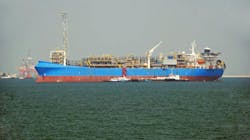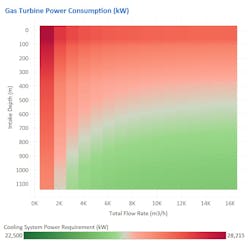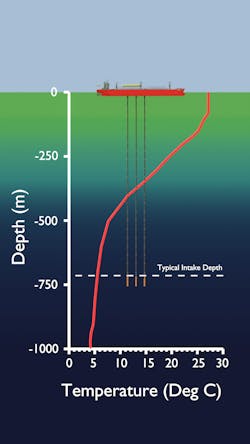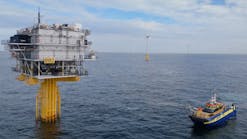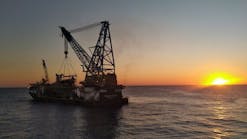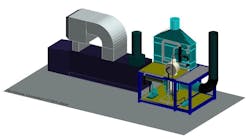Seawater intake risers may help reduce carbon dioxide emissions on FPSOs
Editor's note: This feature article first appeared in the November-December 2023 issue of Offshore magazine. Click here to view the full issue.
By Pete Simpson, Bulent Mercan, and Mike Campbell, 2H Offshore
Floating production storage and offloading (FPSO) vessels are widely used in offshore oil and gas fields. Typically, hydrocarbons are received, processed, stored, and then transferred to shore through tankers or pipelines. In comparison to fixed platforms, FPSOs can be more beneficial due to their flexibility in operations and redeployment capability in remote fields. However, the hydrocarbon processing units on the FPSOs are composed of power-hungry equipment such as gas turbines and compressors. Due to ongoing collective efforts worldwide to reduce carbon emissions, the oil and gas industry is now focusing on redesigning and upgrading FPSOs ever more using novel and efficient technologies.
The industry is getting closer to achieving this target by a) reducing power consumption, b) electrification of as many processes as possible and c) carbon capture technologies. Progress in each of these areas requires the use of several different technologies to make incremental gains towards the target. Deep seawater intake risers (SWIRs), which are used to pull cooler water from deep sea, are an effective part of this strategy in reducing the vessel power consumption by around 8-9% (depending on field conditions).
A large part of the energy produced by the gas turbines on the FPSO is consumed by compressors that are used in the gas separation processes (approximately 30-40%). The efficiency of these compressors is related to the temperature of the gas they are compressing, with hotter gases requiring more energy to compress than colder. The FPSOs utilize a closed-loop cooling system to cool down the produced gases as much as possible via heat exchangers. Cooling water for the heat exchangers is pulled directly from the ocean using SWIRs in an open loop arrangement. The effectiveness of the cooling system depends on the temperature of the water being used.
In more northern latitudes, the water may already be around 8-10°C, but in tropical regions the surface water can be as high as 25-30°C, significantly limiting the efficiency of the cooling system and the potential gains in energy efficiency. While near-surface water temperatures vary significantly by geographical location and season and are mixed in the shallower depths by waves and currents, the water temperature drops off quickly below the surface, reaching a near constant temperature of 4-5°C below around 700 m and deeper. This depth where ocean temperature levels off is called the thermocline, and this is consistent regardless of geographic location, provided the ocean is sufficiently deep.
Consequently, rather than pulling warmer near surface seawater for the cooling system, there is a huge benefit to be able to use this colder seawater from deeper waters directly below the vessel. Access to these colder waters can be achieved via a deep seawater intake riser that extends vertically down from the vessel to just past the thermocline, yielding the following benefits:
- Reduced fuel consumption for the gas turbines, hence reduced CO2 production and an increase in produced gas.
- Reduced gas turbine power capacity.
- Potential for reduced area and weight of required heat exchangers.
Financial benefits
Economically, the extent of these benefits varies significantly with the properties of the reservoir, but in a study conducted based on a Brazilian development on a pre-salt reservoir, the use of a deep seawater intake riser to 700 m water depth in comparison with a near-surface system was shown to produce the following benefits:
- Savings in electricity demand of between 4.5% and 0.5%, depending on the stage in the field life – in the later stages of the field life, the efficiency gains are more modest.
- Reduced fuel consumption by the gas turbines of between 4.5% to 1.5%, depending on the stage in the field life.
- Reductions in CO2 emissions of between 5% to 2%, depending on the stage in the field life.
- Savings of up to $2 million in carbon emission tax per year (depending on the tax rate applied and the stage in the field life).
- Financial gains of up to $1.4 million per year in the increase in produced gas not used as fuel for the gas turbines (depending on the gas price considered).
Technical considerations
These clear efficiency gains are driving the use of SWIR in modern FPSO designs in tropical regions, with at least two different projects in active development which use SWIR that extend to the thermocline. This brings additional technical considerations to design the riser structures. Firstly, the efficiency gain is a function of the volume of water supplied by the system and the temperature of water (which is defined by the intake depth of the riser). The volume flow rate needs to be sufficient to supply enough water for the system, accounting for redundancy of one or more of the risers. Similarly, the diameter needs to be sufficient to avoid flow rates that create cavitation in the pump and could cause too great a pressure loss over the length of the riser, valves, and elbows.
Typically, two to three SWIRs are required, with flow rates on the order of 10,000m3/hr and riser diameters in the order of 1.5 m. This makes steel solutions impractical due to production, installation, and fatigue issues. Recent studies have shown that large-diameter high-density polyethylene (HDPE) pipes are more suited to the application. However, the light weight of the pipe requires a ballast module to limit the displacement of the riser and ensure tension along the length of the structure.
Careful studies are required to confirm the design of the SWIR and ensure that it will be fit-for-purpose for the full design life. Careful attention needs to be paid to the following aspects of the design:
1. Collapse resistance of the pipe (if HDPE) during moments of low internal pressure post-startup.
2. Design of the vessel/SWIR interface which must absorb the relative motion between the vessel and the riser.
3. Tension levels and stresses in the riser wall in extreme storm conditions.
4. Creep of the HDPE material over time with the applied axial load from the ballast weight and vessel motions.
5. Fatigue of the pipe material due to wave loads and vortex induced vibrations.
6. Fatigue and loads on the pipe during installation and towing to the site location.
7. Internal flow within the riser and heat loss.
8. Interference of the riser with each other or adjacent structures.
Looking forward
Deepwater SWIRs can be a key technology in driving the efficiency of offshore FPSOs towards the elusive “Net Zero” goal. Such systems are particularly applicable for deepwater tropical locations, which matches well with the principal geographic market for large FPSOs, which are Brazil and Guyana. There are some technical challenges in designing workable solutions, but these are being studied and resolved and the first systems that extend past the thermocline should be installed in the next few years.
